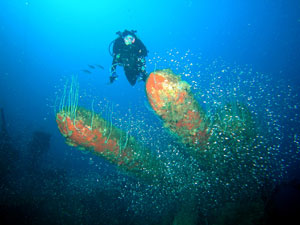The Value of a Wreck Diving Course

Photo Provided by Bill Downey
Shipwrecks are bits of history, frozen time capsules of the era they sailed, even on the day the ship went down. To explore a shipwreck is to learn about the past. Once you visit a wreck, you’ll almost always want to know more about it. Or, you may learn about an undiscovered wreck and feel the urge to research it and locate it for diving.
The wreck of the Royal Mail Steamship Rhone is an example of a classic shipwreck and one of the most picturesque wrecks that you can explore. She sank in 1867 in a violent hurricane that ripped through the British Virgin Islands. The huge open end wrenches used to work on her engine are still in place, as are the cannons used to defend her. You can see the crow’s nest, the mast, and many other parts of the engine and ship’s fittings.
As you become involved with shipwreck diving, you’ll undoubtedly want to know why each wreck sank, how it sank, and when it sank. The stories behind wrecks are almost always fascinating to discover!
Additionally, shipwrecks are great places to see marine life, because they provide hiding places and opportunities for both small and large marine creatures. Lobsters can be found inside ship’s cabins, under deck plates, and inside masts and pipes. Barracuda swirl around tropical wrecks. Tiny fish known as “glassy sweepers” school by the thousands inside warm water wrecks around the world. Soft corals wrap their tentacles around the railings of old freighters and spiny oysters grow on any available surface. Yet, the shape of the wreck can still be seen beneath these mantles of living creatures.
For underwater photographers, shipwrecks present an infinite variety of photographic opportunities, whether you want to shoot macro close-ups or wide angle. You can capture images of tiny, colorful starfish living on the hull of a ship, or frame a diver examining a giant ship’s propeller. If you shoot video, your viewers can make a “virtual” dive by watching your explorations on tape or computer.
The experiences, tips, and techniques in SDI’s Wreck Diving Course are the result of many years of diving. This course will cover, in considerable detail, all the elements of diving from both commercial charter vessels and private craft. Everything from how to stow your gear, to applicable local and government regulations will be discussed, along with valuable explanations of methodology and etiquette. And since many sites require divers to deal with currents, we have incorporated special instructions on drift diving practices as well.
You’ll find this text to be a valuable resource on an exciting subject. We’ve enjoyed putting it together and hope you’ll enjoy the wonderful benefits of boat diving and the exploration of wrecks as much as we have. Good diving!


اترك رداً
تريد المشاركة في هذا النقاششارك إن أردت
لا تتردد في المساهمة!